English Country Style
Can Americans capture the look? Top British designer Ben Pentreath says no.
Supreme Court Justice Potter Stewart once famously said of obscenity that is was hard to define, but he knew it when he saw it. The same could be said of the English Country style. It is easy to peg the look the minute you step over the threshold or an image flashes across your screen but the style’s variability and idiosyncrasy make it difficult to describe precisely in simple terms. From grand manor houses to small apartments, many places can embody this style. It offers homes layerd with carefully collected objects, and as a result, environments with a deeply comfortable vibe. They are lived-in with nothing too perfect. In essence rooms appear put together but somehow undecorated, like they always looked that way. Since the best way to fully appreciate the dynamics of English Country style is to see it, I will share plenty of images, many exclusive from my travels, at the end of this post.
Although there is not an exact science to fashioning interior decor, including English Country (it’s more an art than anything else!), there are some aspects that regularly appear in residences that nod to the English Country tradition. Knowing them can help you capture the look for yourself. For one, the house’s architecture and a sense of place is always respected. “The inside must be what the outside prepares you for,” acclaimed British designer David Mlinaric once said. Color, pattern and natural materials are essential. A soupçon of rough luxe (think stone floors and rush matting) never hurts but, as previously noted, upholstery is plush and inviting. Furnishings meld in a mix of periods. While interiors are usually replete with antiques, these are frequently punctuated with hints of modern. The display of personal treasures is foundational to the design style and can add a touch of whimsy.
Recently, top British designer Ben Pentreath, a favorite of aristocrats (Pentreath’s most recent book is dedicated to King Charles), said that the layered collected look at the core of the style is inherently British. According to Pentreath, American designers can’t get it right because they produce rooms that are too perfect. If you give an American architect or decorator a directive to create a home in the “English style,” Pentreath claimed on Dennis Scully’s popular podcast Business of Home, “….… it will not feel in any way, shape or form, English,” adding that it will inevitably be “over-designed.”
Pentreath wrote more expansively on the topic in Country Life magazine where he said Americans mess up the look because they slavishly follow what they imagine to be the English Country recipe. No shade to Connecticut and its designers from me, but for Pentreath “…nothing feels and looks (or smells) less English than a Connecticut country house where the architect was asked to design in the ‘English Style’ and the decorator created a carefully layered ‘English Interior’. ”
Gee Ben, you hurt my feelings.
I am a fan and proud owner of all three of your books. But nothing gets under my skin more than categorical, broad statements presented as truth (especially in these times). Frankly, they are almost always wrong. So I am here to stand up for Connecticut and for the many many homeowners, designers and architects (myself included) who do in fact create comfortable and well designed homes endowed with personal collections within an aesthetic that respects the architecture and local vernacular— and draws some inspiration from English decorating.
While I agree with Mr. Pentreath that houses done in the English Country tradition mustn’t look too new, most designers in the US work overtime to highlight their clients’ personal treasures, be they family heirlooms or new collections. Unless directed by the client to do so, nobody says to throw it all out and start from scratch. And of course such an idea is generally impractical (and generally abhorrent) for most homeowners. The only caveat: this manner of decorating takes time and patience and all parties involved must be in sync on this score.
Ironically, the English Country style is not entirely “British.” Design history attributes the moniker “English Country” to the style of a Virginian, Nancy Lancaster, who brought her notions of Southern hospitality and comfort with her when she came to live across the pond in a series of grand manses. It was Lancaster who installed cozy sofas and chairs (and more bathrooms!) in those piles finally making them livable. She was also known for her witty touches like pairing a Delft garniture over a grand fireplace with a fanciful textile depicting similar vessels on a nearby wing chair. The Duchess of Devonshire, Deborah Cavendish, once said of Lancaster that “(w)hatever she touches has that hard-to-pin-down but instantly recognizable gift of style, arresting in its originality and satisfying to the spirit." Although Nancy Lancaster never called herself a decorator, she later purchased Colefax & Fowler (the British decorating firm most synonymous with the English Country style) and worked in tandem with the legendary John Fowler. Lancaster created the iconic“Yellow Room” for her drawing room while she was in London on company business.
Since Lancaster’s days (she died in 1994), the English Country style has evolved. As I recently wrote for Frederic Magazine, it is David Mlinaric who deserves much of the credit for keeping the style fresh. He decluttered the look but kept the comfort. Mlinaric re-energized the style from Nancy Lancaster’s days by bringing in more contrast. For example, he is one of the first to combine luxe upholstery with more tactile, rough elements such as stone floors and sisal rugs. And similarly, he often inserted contemporary art and furnishings among older objects in his rooms for a bit of dramatic tension.
I count myself as one designer who has created homes in the English Country tradition, my own included. Long before the look’s current vogue and well before the internet, my now-deceased husband would stuff every British shelter magazine he could find at Heathrow in his carry-on for me to devour while he reacquainted himself with our three sons upon his return. Today, my 1922 prewar coop reflects that early inspiration. It has all of its original architectural details, and I’ve combined favored furniture, art and objects from 3 prior residences and a lifetime spent collecting. Then there is the Victorian I rebuilt after a devastating fire that looks to all like it was always there, indoors and out. This Old House magazine understood my intention and featured it on its cover.
Back in 2010 when I was decorating for others, a British native retained me to furnish her 7000 square foot Federal period house in upstate New York in a manner consistent with her birth country’s ideas of style. She gravitated to a more understated, less patterned version of English Country often featured in a British magazine called The English Home, a title I highly recommend. This was her second home, so by necessity, she had to purchase most everything from scratch. Not wanting only newly manufactured furnishings, we bought a few pieces and some traditional oils from the previous owner and then went antiquing all over Connecticut and New York. In the entry alone we mixed three different periods. An early 19th century drum table found in Connecticut sits on a contemporary rug from BDDW. A new bench designed by Eric Cohler has Greek key details that nod to the house’s neoclassical architecture and above it hangs a midcentury metal sculpture by Curtis Jeré. We retained the original lantern ceiling fixture. Just beyond the entry you catch a glimpse of a large drawing room and a traditional oil that came with house. The chair is new and I also added the sconces. You be the judge based on the image below, but I do not think the result looks “formulaic” or dated.
The rest of the house continues to blend old and new with a plan to enhance the collections over the years. In the dining room for instance we combined the original chandelier and a dining table purchased from the prior owners, with an early sideboard and klismos chairs we stumbled upon in the antique warehouses once ubiquitious in Stamford, CT. (Really Ben, you must believe me, there is great stuff to be had in Connecticut.) The upholstery on the chairs was appealing so we left it. While the husband was away on a business trip, he spotted a marvelous contemporary aerial photograph. His wife and I immediately gave it the green light for the space to add that touch of edge to the older, more traditional pieces.
There are many other designers and countless homeowners stateside who do a fine job designing multifaceted interiors that aren’t remotely like the faux, matchy matchy, “too perfect” look that Ben Pentreath disdains. Head to the Instagram account @oncewewereenglishmen to see their work alongside that by our British allies, because there are too many to name them all.
One home in particular, a sea captain’s cottage in the Pacific Northwest, stands out. Designed by American designer, Markham Roberts, it is very sympatico with homes across that pond and is proof positive that we can get it right over here. A riot in pattern and color, the cottage was passed down through generations until ownership finally reached Roberts and his partner. As soon as the couple got their hands on it, Roberts stripped fake Victorian wallpaper and borders from the walls and recovered them. For this, Roberts used custom-colored fabrics from Décors Barbares as well as wallpapers from the likes of William Morris. The couple re-purposed their vintage textile collection to fabricate freshly-designed pillows and upholstery. Other furnishings are a combination of old pieces accumulated over the years and recent estate sale finds. Art was slowly collected specifically for the house. The cottage was published by UK House and Garden, so the editors there must have agreed that he did a fine job — and one brilliantly commensurate with British style.
I would love to hear if you think Ben Pentreath was too dismissive of American decorating. I obviously took umbrage, probably stemming my own trauma of losing and then having to rebuild a new, “old” house from the ground up . At the end of the Scully podcast, Pentreath allowed that he didn’t have many American clients despite the popularity of his books and his Instagram page. I can’t help but wonder if he needs to get to know us Yankees better. Do you agree?
As I said at the outset, I love seeing real British homes firsthand and I will share some of my favorites from past travels below, including one you probably haven’t seen before by John Fowler. Nothing beats inspiration from our mother country and I am heading back to England with the Decorative Arts Trust this June for more. Additionally, keep scrolling if you want to see some images from my upstate New York project and Markham Robert’s dreamy home. I will write more about my current apartment soon. I am waiting for the cherry tree to bloom in the sweet, private garden outside my window before I shoot and share images with you.
I hope you enjoy the armchair travel and please feel free to give me feedback about this post.
Bon voyage,
Lynn
Photography
Homes from across the pond. Photographs by Lynn Byrne.
Lead photo above, a homeowner’s pretty drawing room in Northern Ireland with floral wallpaper and 18th century Gothick (always spelled with a “k”) architecture. The little rooster perched on the wall bracket and the safari hat resting on the stack of books add the witty, whimsical touches pioneered by Nancy Lancaster.
Below, Lady Bangor’s sitting room by John Fowler, decorated in Emma chintz from Colefax & Fowler in Northern Ireland’s Castle Ward, followed by a letter from him with its specifications. The space has more marvelous 18th century Gothick architectural details. Chintz is a favorite for many English Country style aficionados.
I love the inclusion of the Scandinavian midcentury wishbone chair at the desk in this room below, also in Northern Ireland. The homeowners included it and other Scandinavian furniture throughout their home because the wife hailed from Denmark.
In the same house as above, the homeowners chose an artichoke chandelier by Poul Henningsen from Louis Poulsen to contrast with their otherwise traditionally appointed dining room.
This homeowner of a village home in Northern Ireland selected bold paint colors drawn from his topnotch porcelain collection.
In the private homeowners’ drawing room at Northern Ireland’s Mt. Stewart not much has changed since Nancy Lancaster’s hey day.
In contrast, the owners of Otley Hall, an important Tudor period home in East Anglia, updated the decor using more texture and neutral fabrics. This “rough luxe” treatment lets the early architecture and leaded windows shine. Check out the original linenfold paneling in their dining room.
Homes stateside.
My Upstate New York project. Photographs by Ellen Mcdermott.
The entry with a view to the adjacent drawing room with furnishings from at least three different periods, is less dependent on pattern to suit my British client’s understated taste. The paint color in the entry and the wallpaper in the dining room are both by Farrow & Ball.
Here in the dining room you can catch a glimpse of the contemporary aerial photograph that the husband found hung in the corner.
The old sea captain’s cottage in the Pacific Northwest by Markham Roberts that is packed with color and pattern. Nothing matches but everything “goes” and it looks like it was born that way. Photographs from UK House Garden.
Further Reading
Want more? I once had lunch with Edward Bulmer, the founder of the next great British paint company, at his home in England near the Welsh border and it is divine. Stateside, there is this wonderful apartment on Central Park West by Miles Redd.
2. Two essential books for your design library:





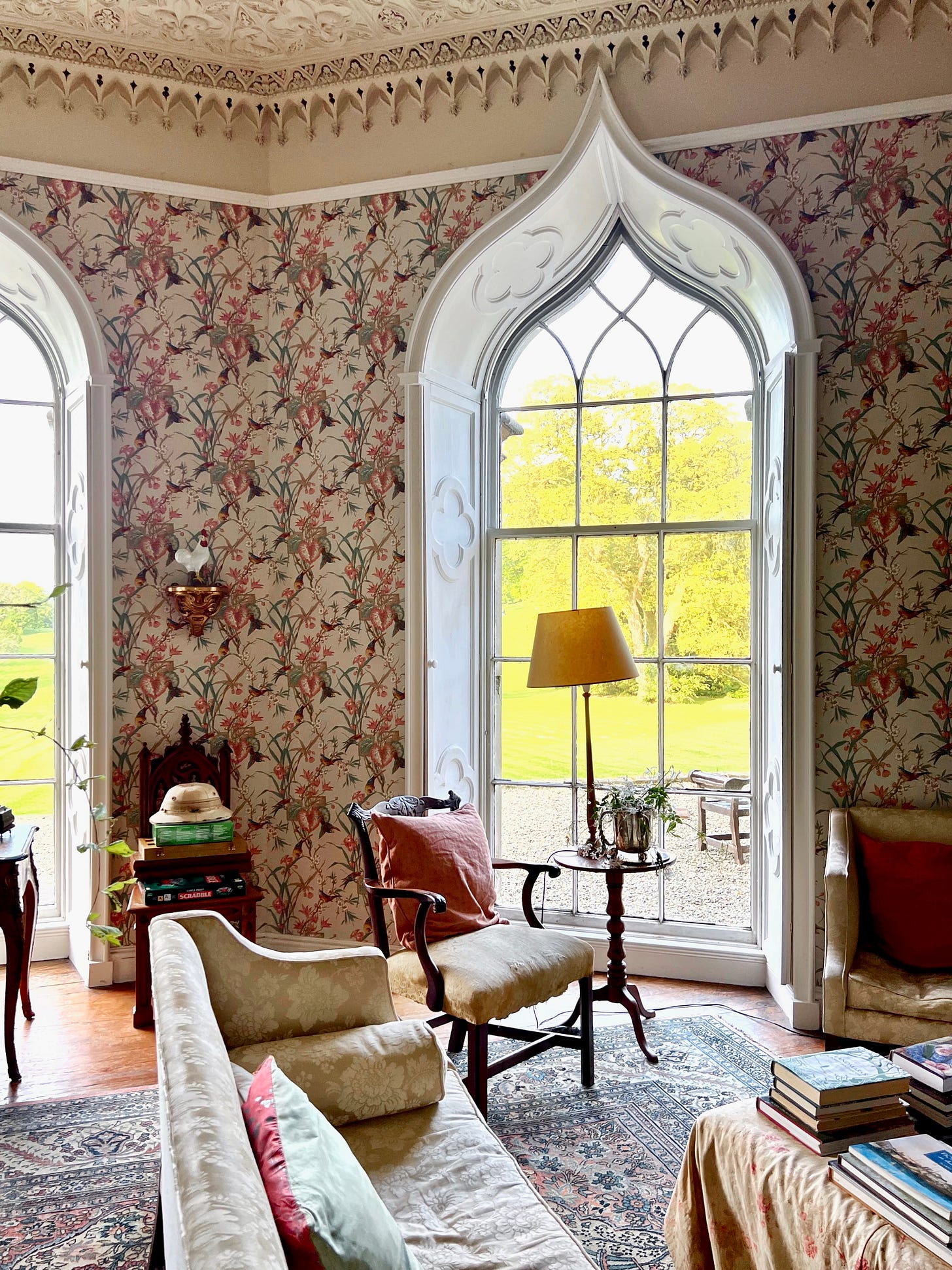
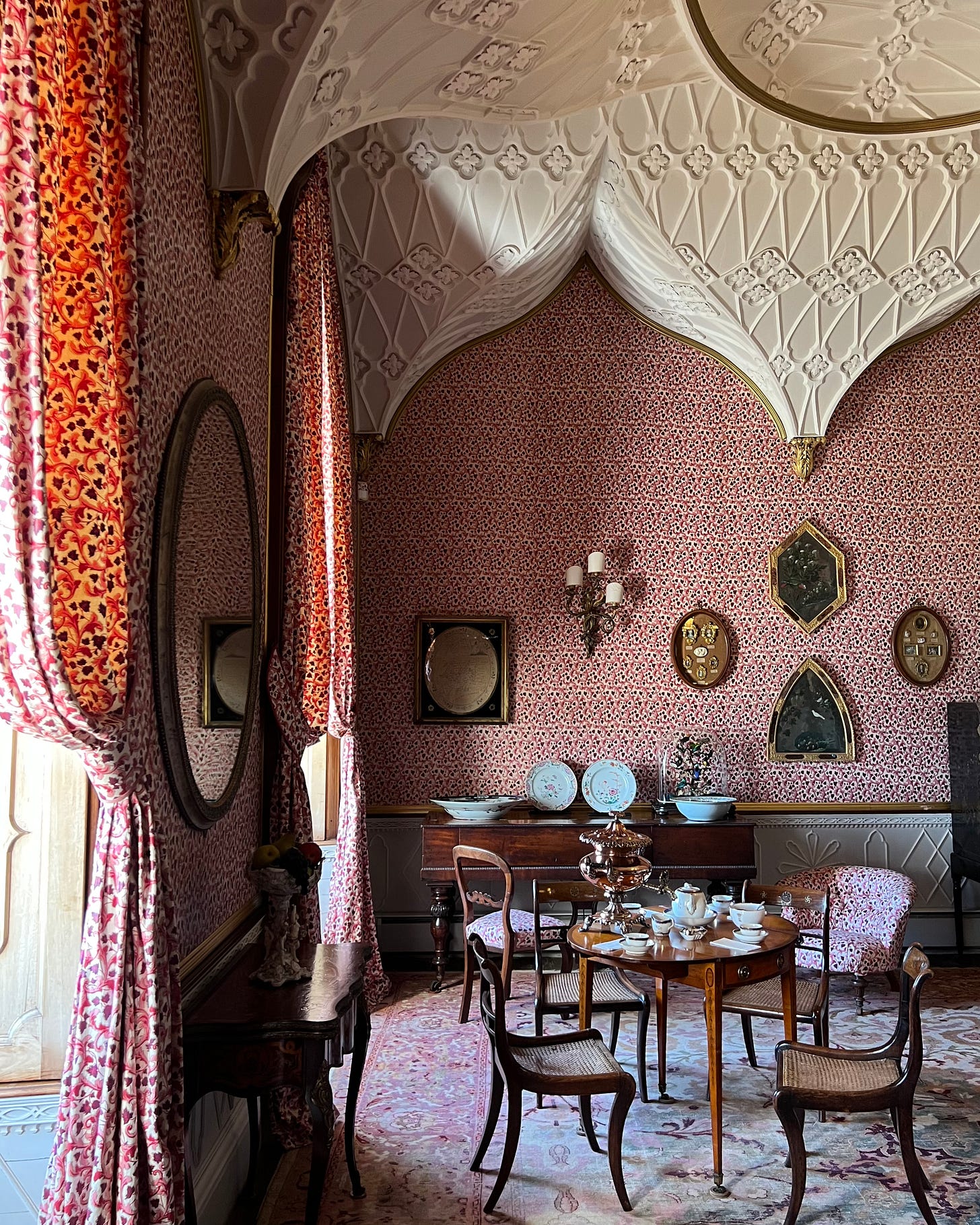

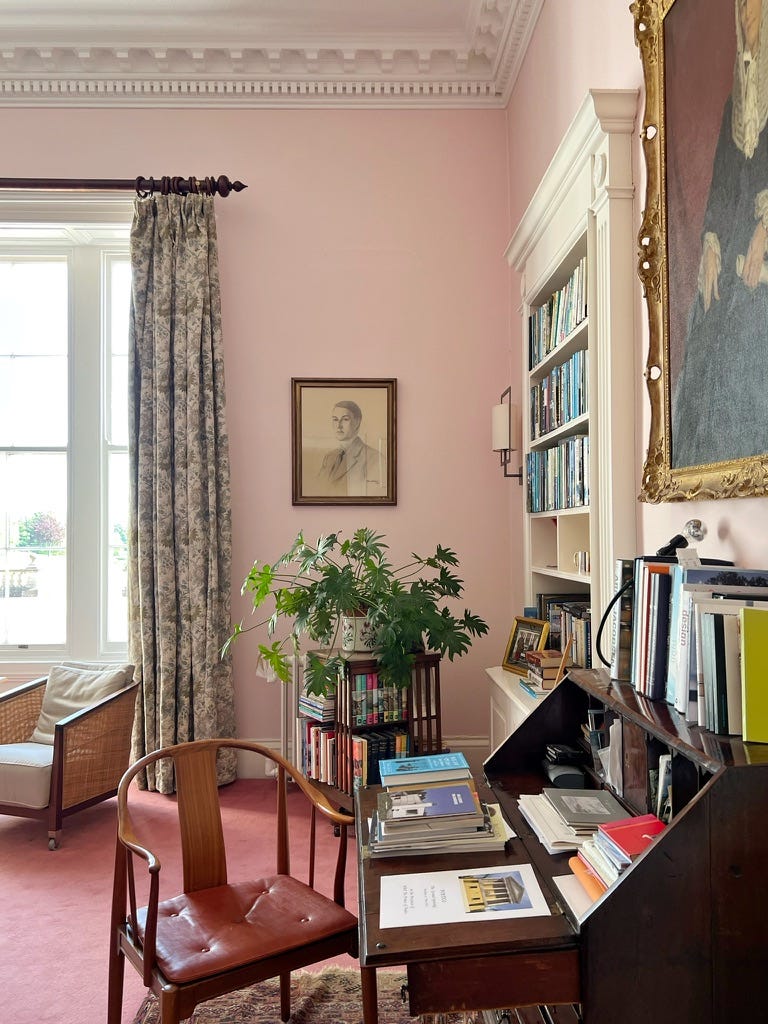
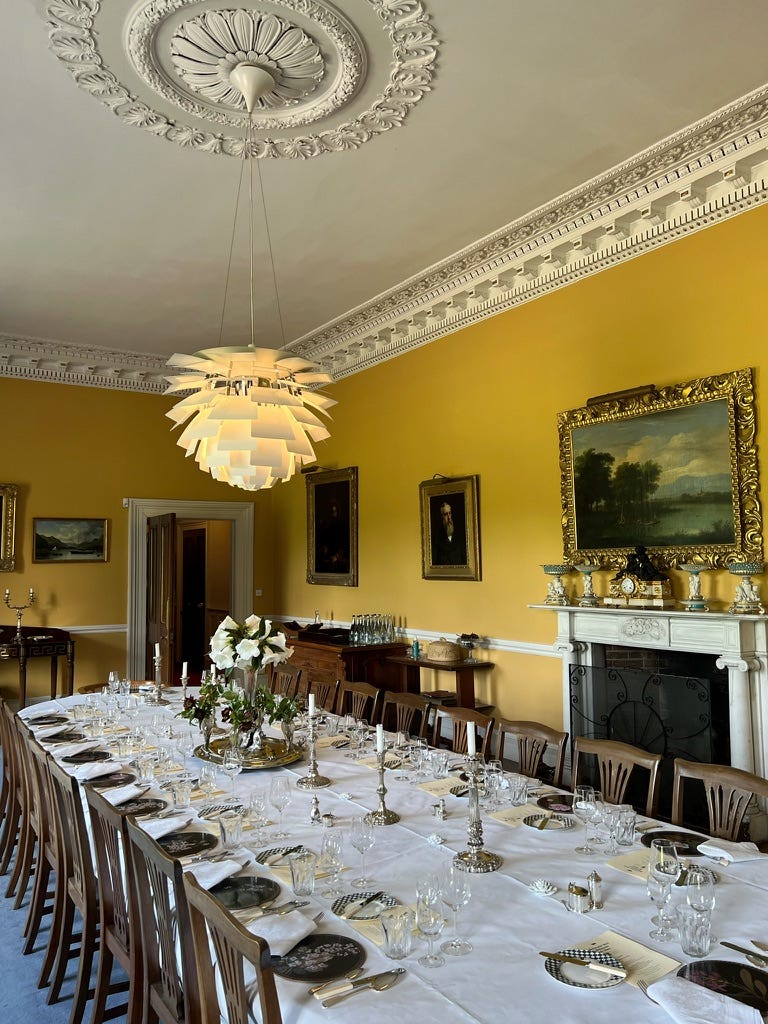
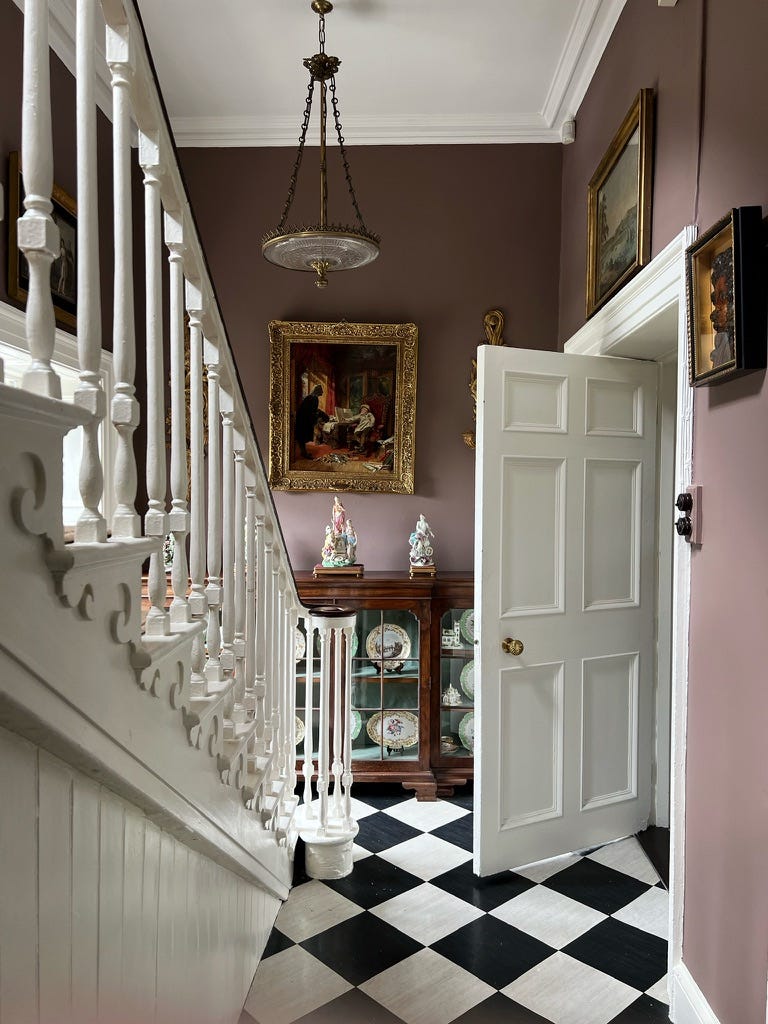
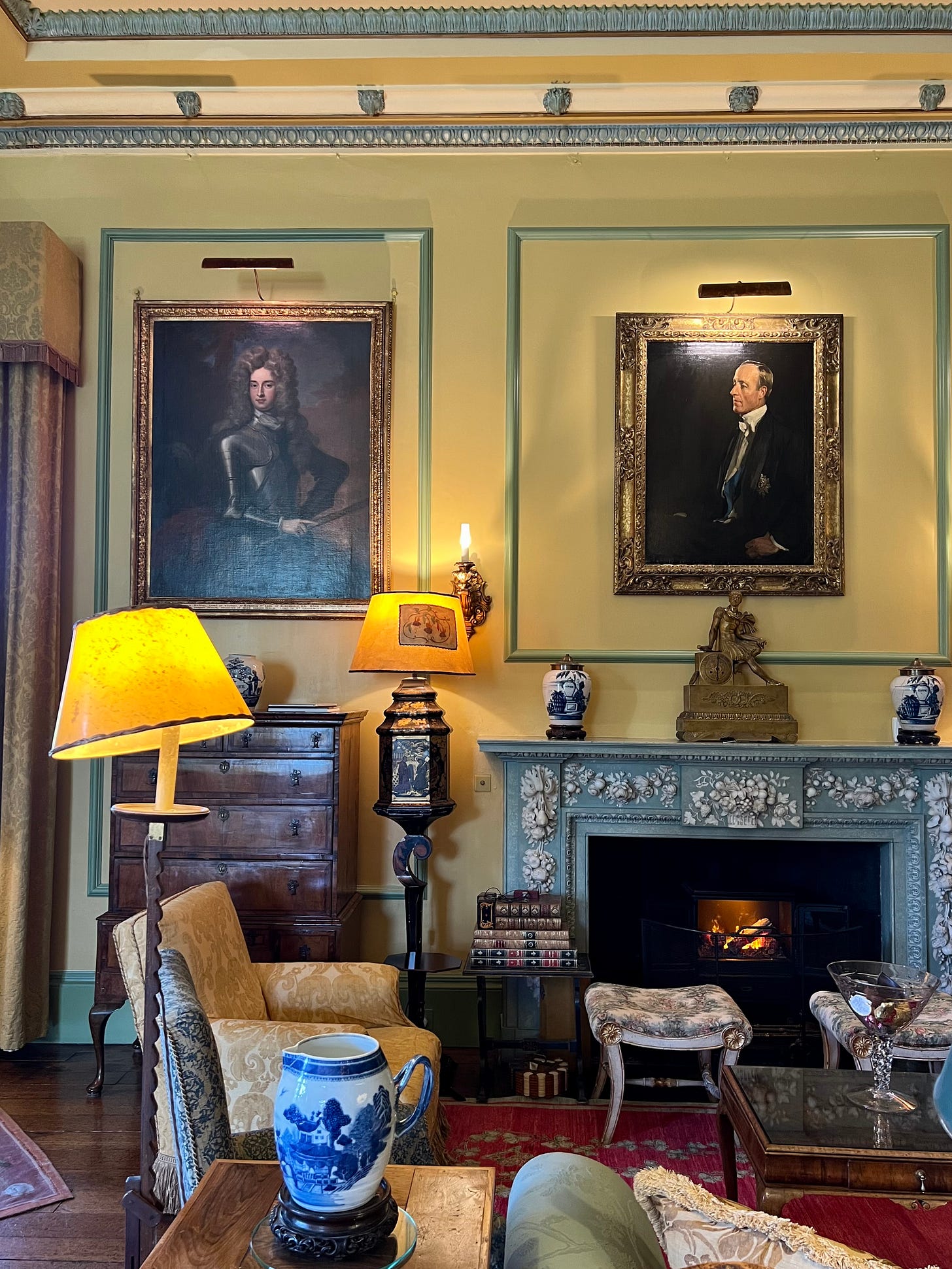
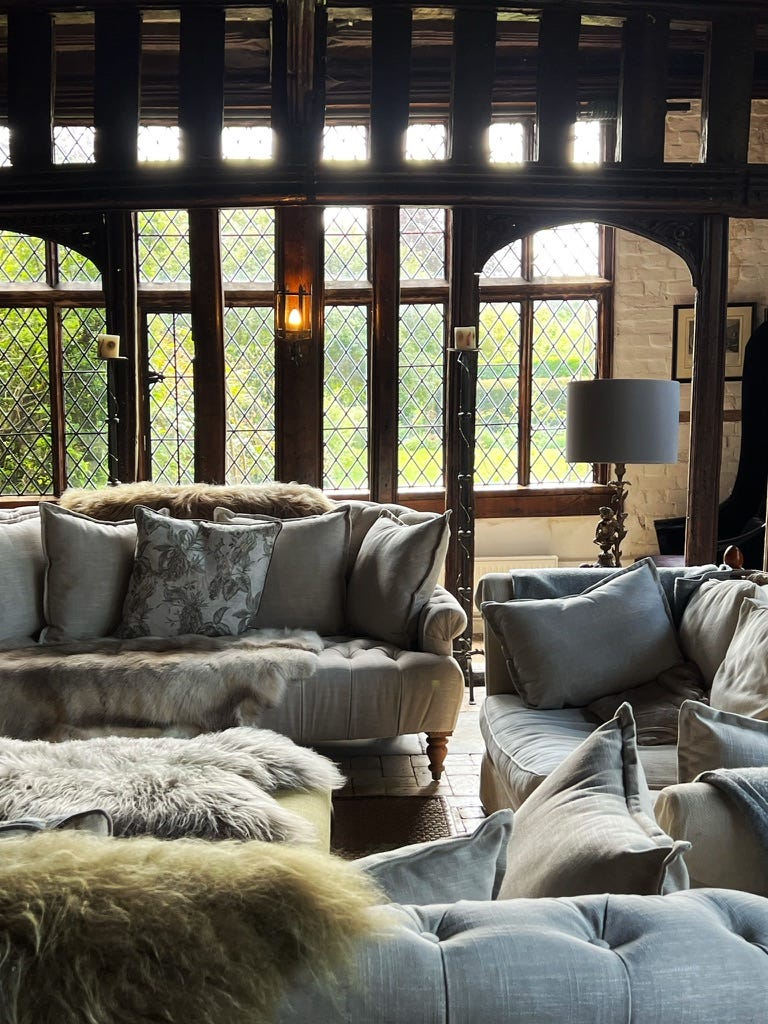
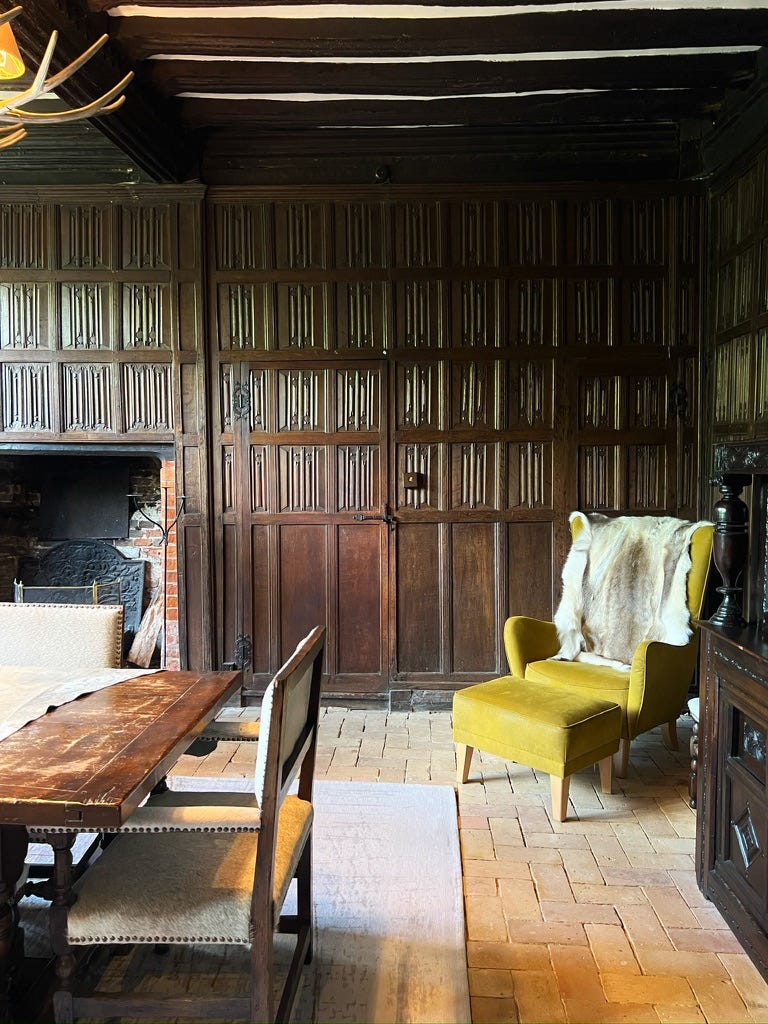
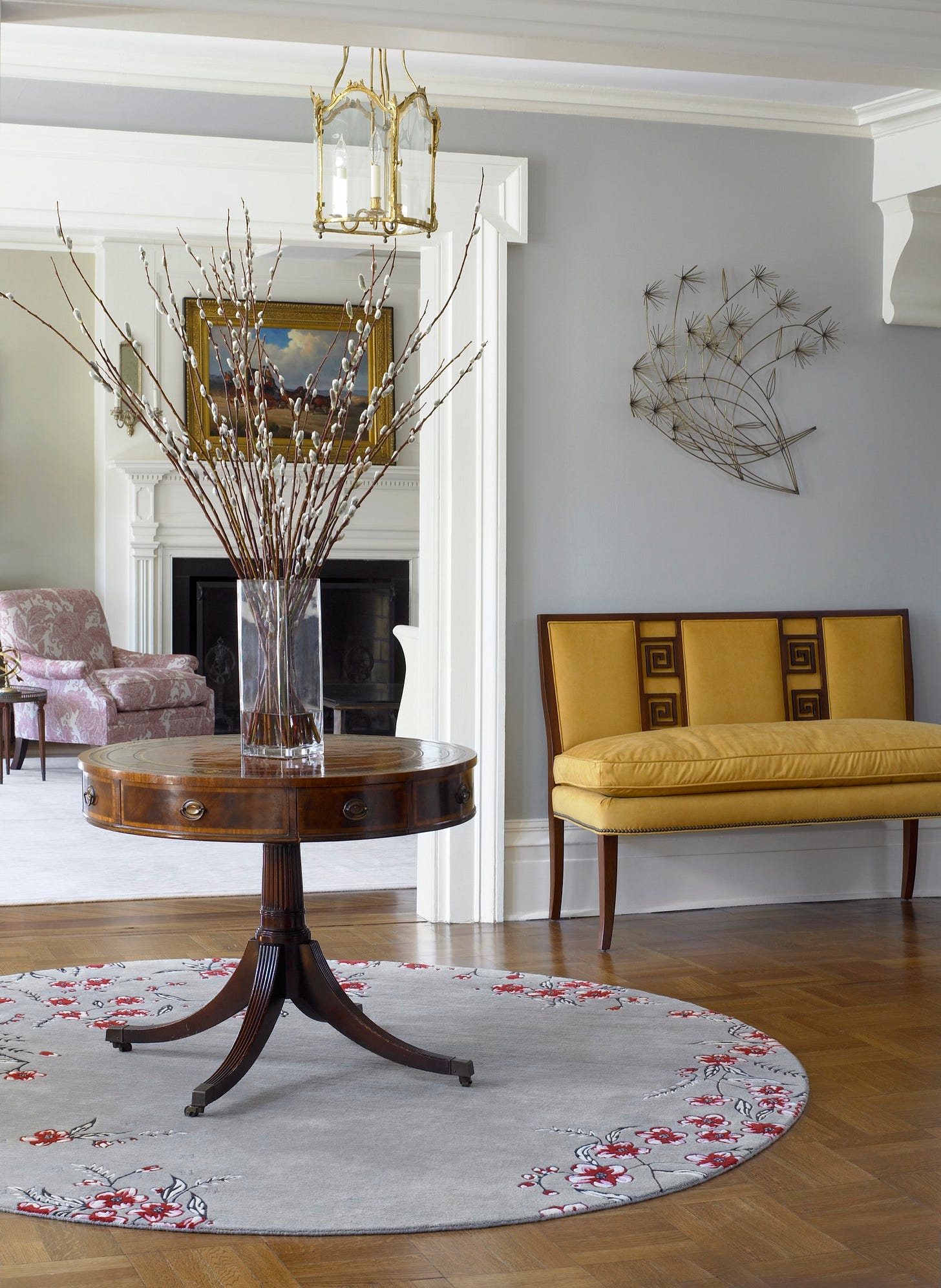
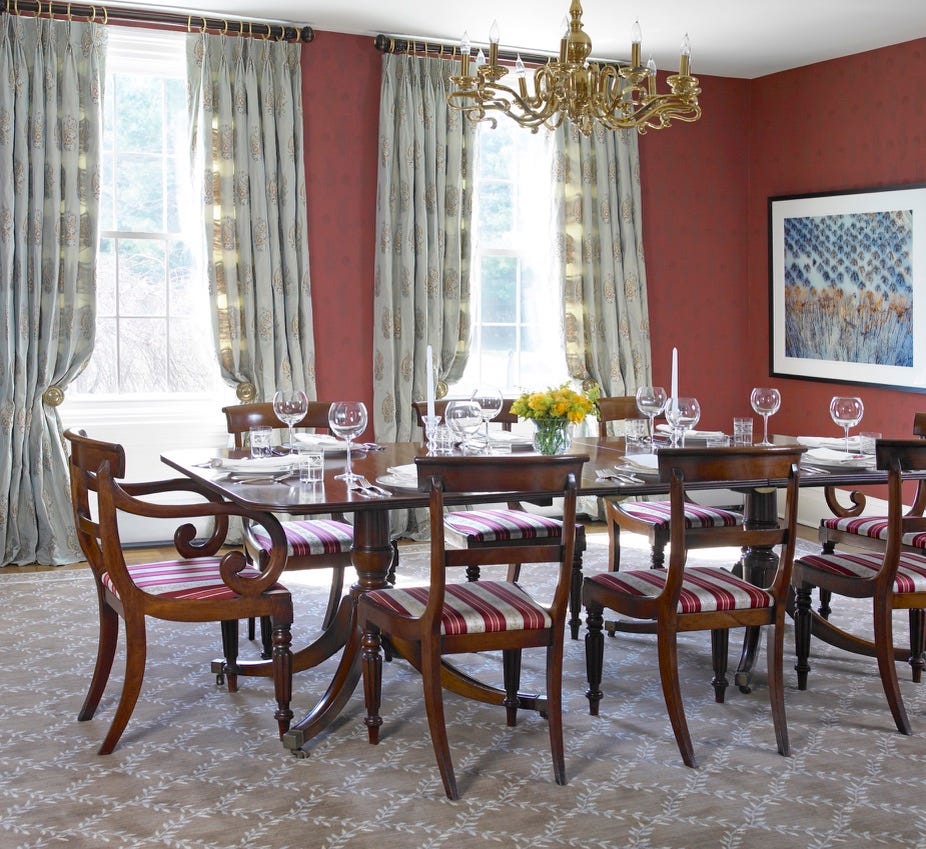
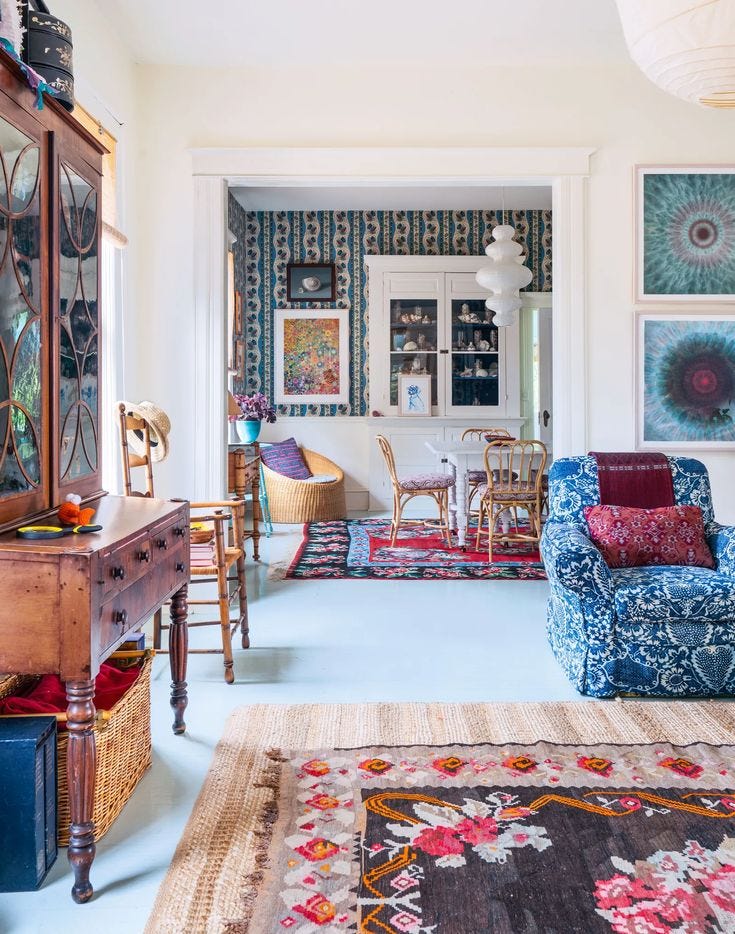
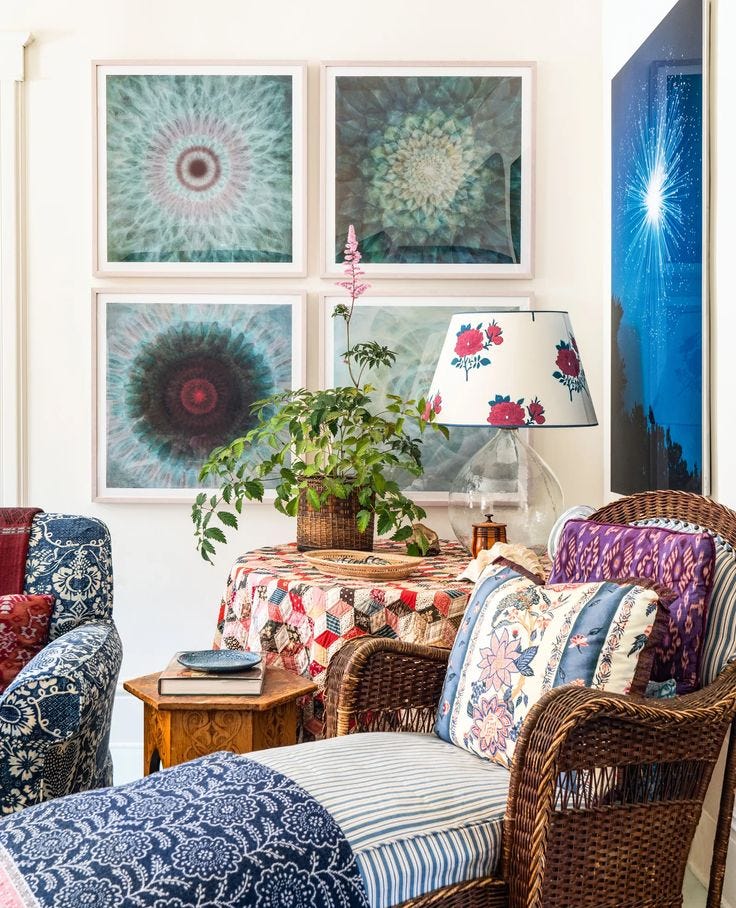
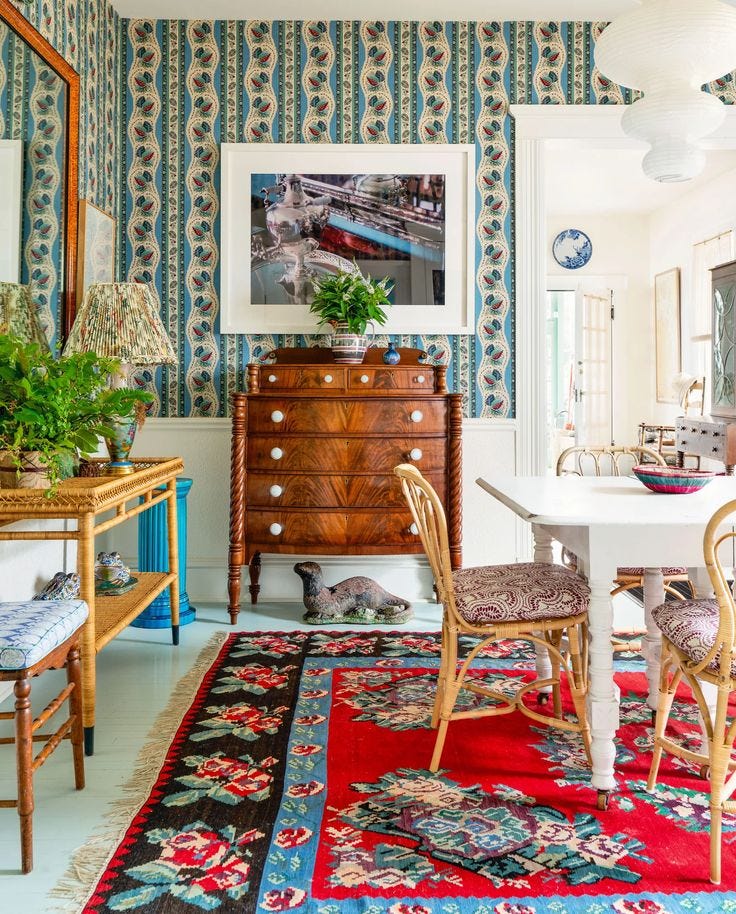
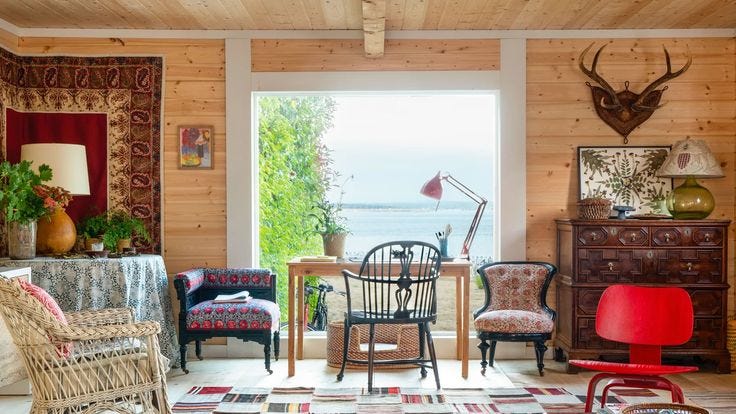

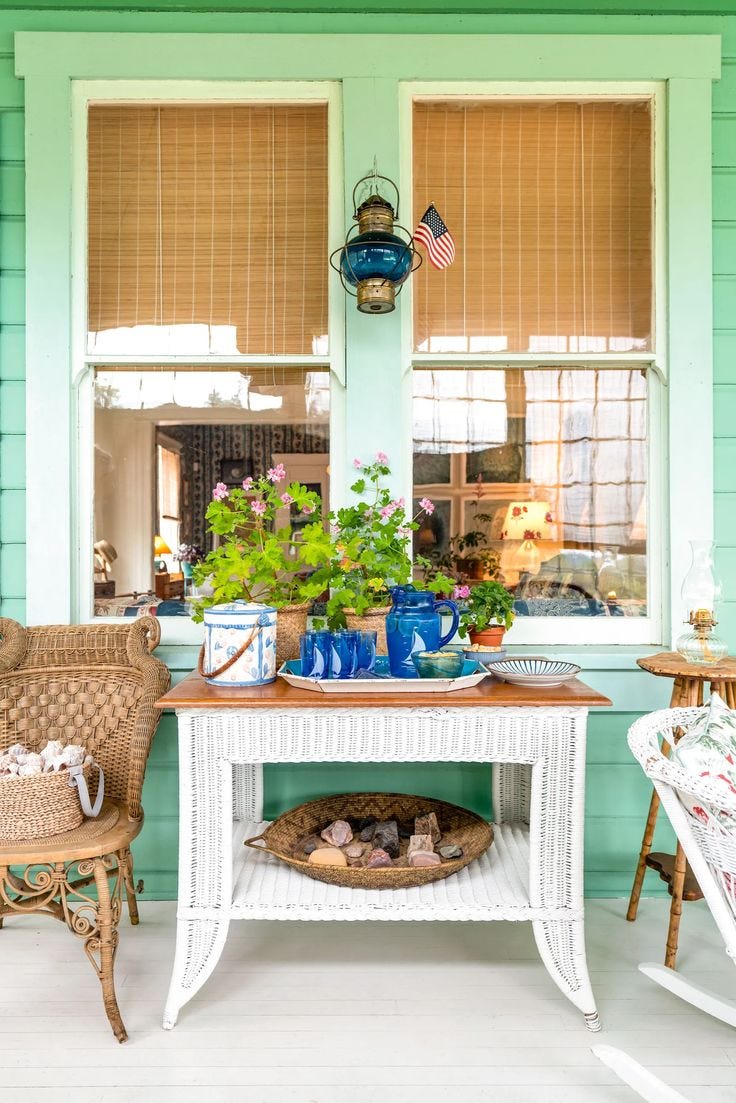
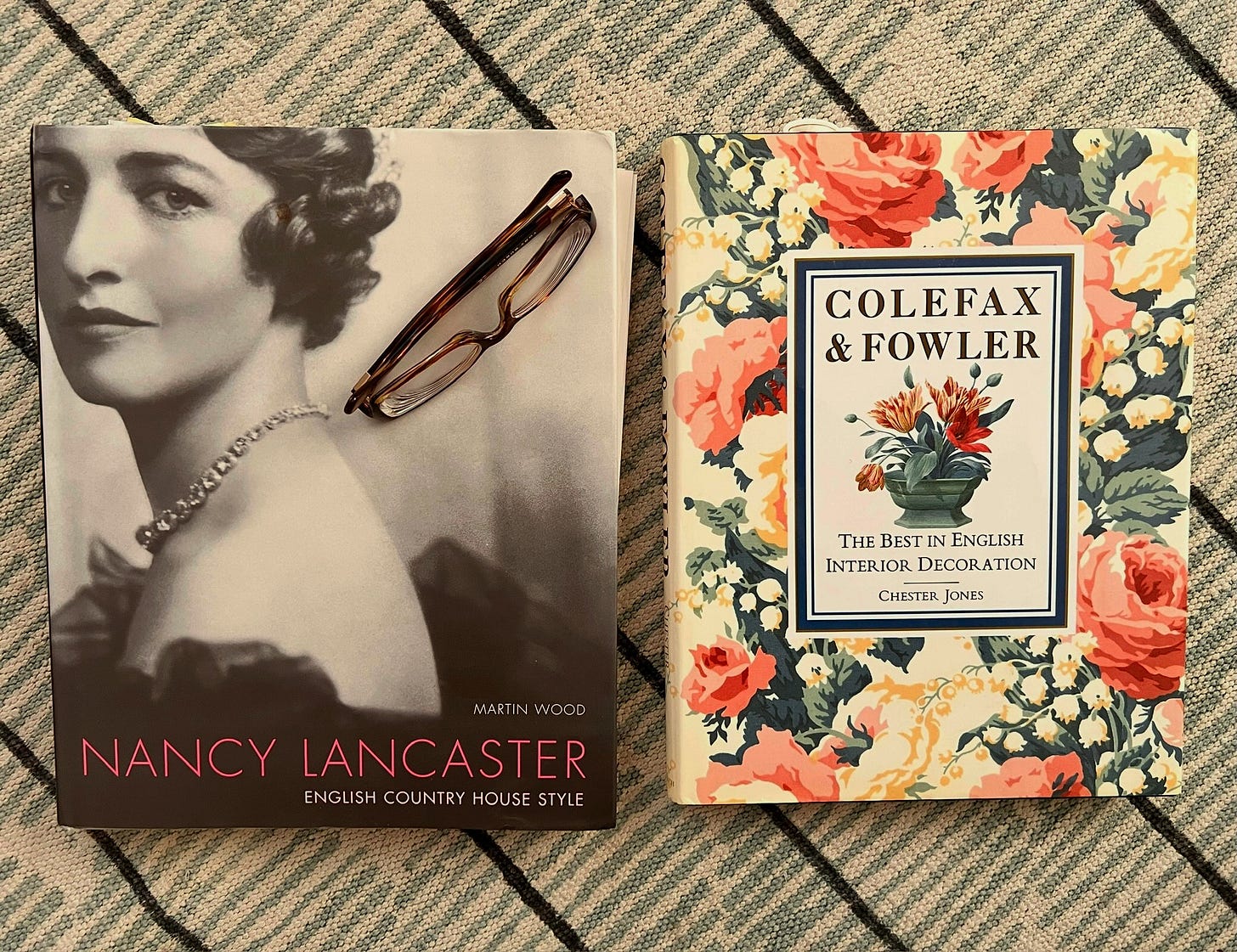
I didn’t know this about style and Englishness suspect this only means enjoy your own sense of colour and things you love.
This is an interesting question, and I think inevitably the answer is no. English style, done anywhere other than England, always reads falsely - it's a response to their own vernacular architectural style, weather, light, design history. The best American interiors react to all those things but in an American way. They can definitely be layered, and have patina and feel "right", but to try to ape and be "English" is just wrong. I say this as an Australian (who trained and worked in England) where "English" interiors just never feel right in our country. Fortunately it's rarely requested by clients to slavishly copy, rather you borrow ideas and tweak it in a way that works locally. I think the biggest barrier (and it is a generalisation to say this) is that American designers tend toward perfect symmetry, a level of coordination with textiles, and a polish that is not part of an English design sensibility.